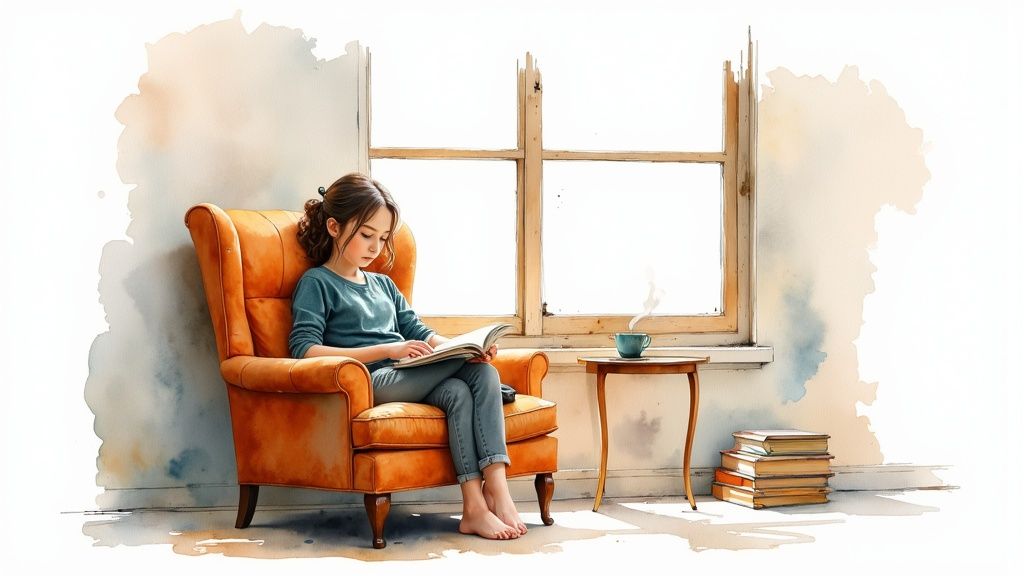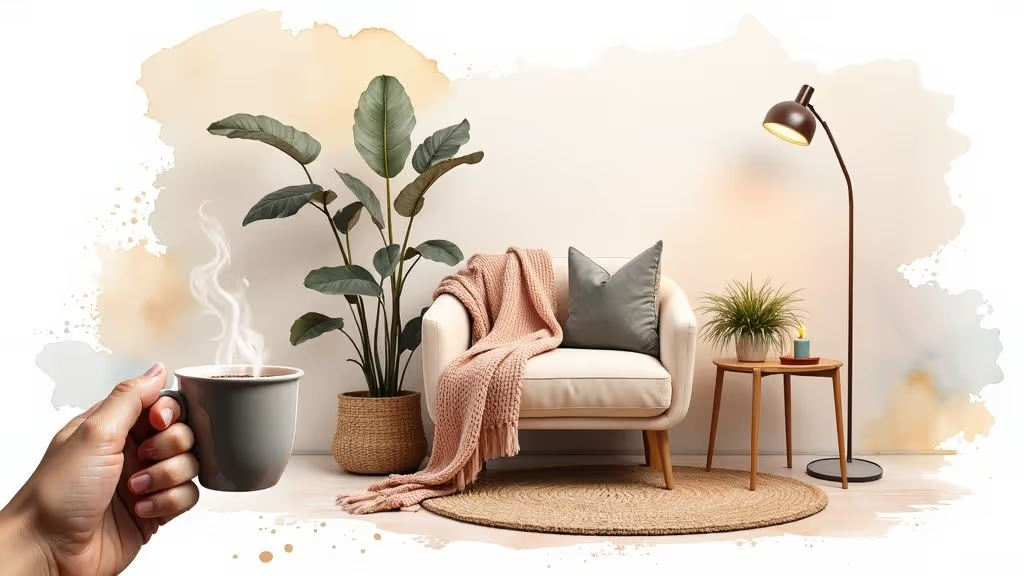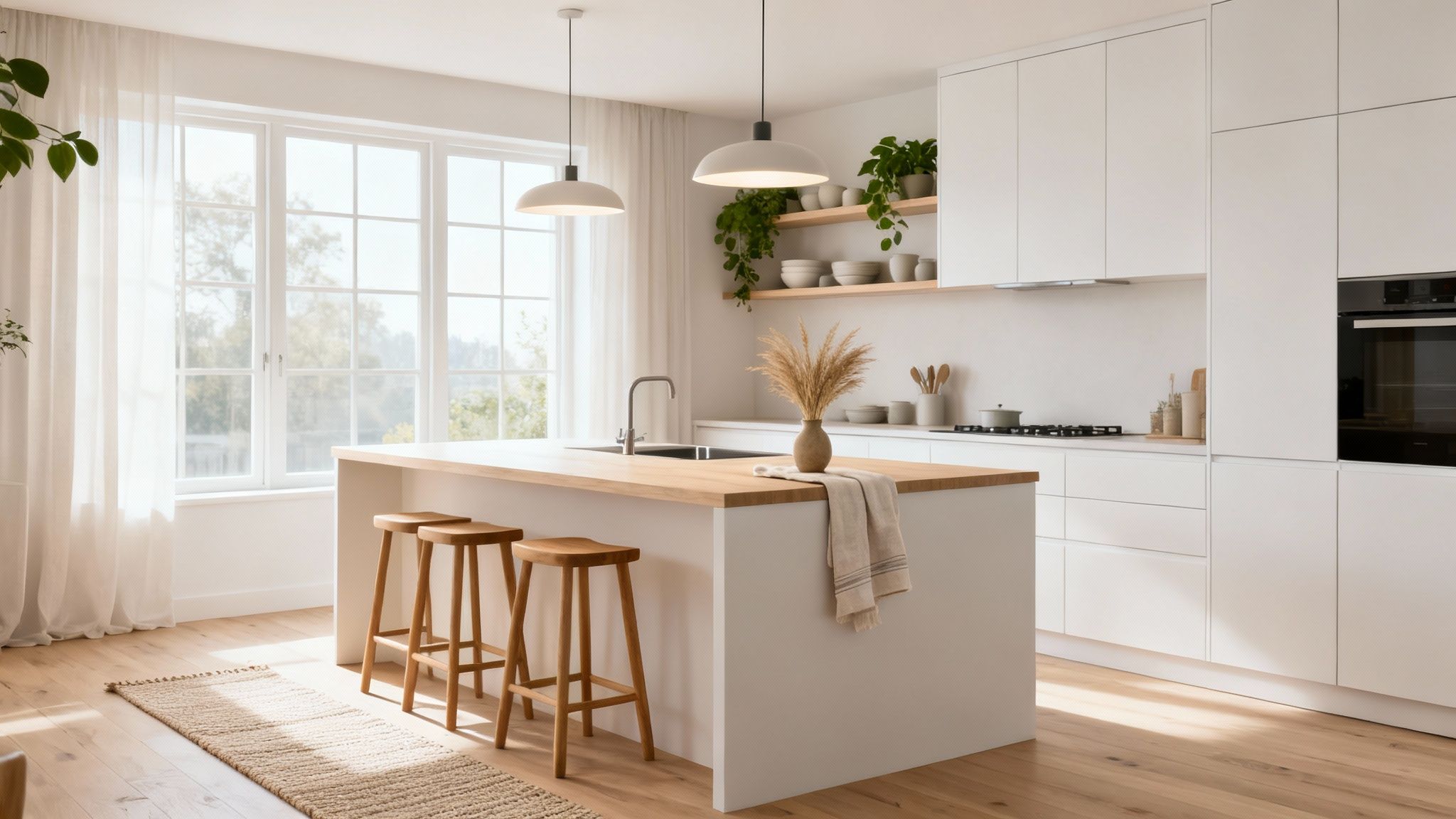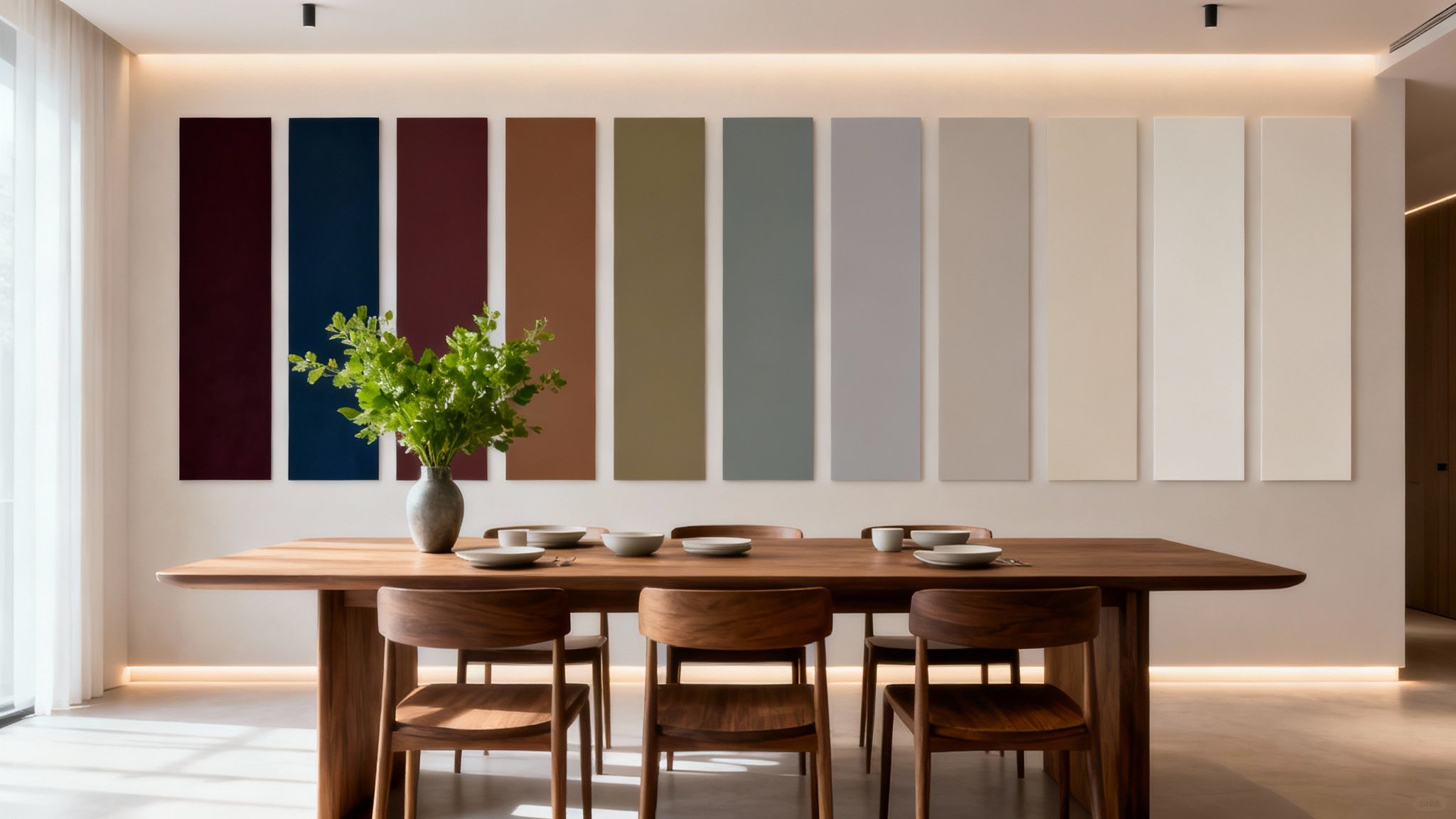In a world that often feels fast-paced and demanding, our homes have become more than just a place to live; they are our sanctuaries. The desire for a space that feels warm, inviting, and deeply personal has never been stronger. This is the heart of creating a 'cosy home', a concept that goes beyond mere aesthetics to cultivate an atmosphere of genuine comfort and contentment. It’s about crafting rooms that encourage you to slow down, relax, and feel truly at ease.
Many people believe achieving this requires a complete overhaul or a huge budget, but the reality is that the most impactful changes often come from thoughtful, specific details. This guide moves beyond generic advice to explore 10 actionable and practical cosy home ideas. We will delve into specific strategies, from the art of textural layering with soft furnishings to the transformative power of warm lighting design and the personal touch of curated gallery walls. Each idea is designed to be inspiring and easy to implement, offering fresh perspectives on how to infuse your space with enduring warmth and character. Prepare to transform your house into a haven you will never want to leave.
1. Warm Lighting Design
One of the most impactful yet often overlooked cosy home ideas is to move beyond a single, harsh overhead light. Instead, embrace a layered approach to illumination. Warm lighting design involves strategically placing multiple light sources at different heights and intensities to create pockets of warmth, eliminate stark shadows, and foster a sense of intimacy. This technique, popularised by the Danish concept of hygge, transforms a room from purely functional to deeply inviting.

How to Implement Layered Lighting
The goal is to create a soft, ambient glow rather than one bright, central source. Think of boutique hotels or serene reading nooks; they use a combination of floor lamps, table lamps, and sometimes even candles to achieve a welcoming atmosphere. This method allows you to tailor the light to the mood and activity, whether you're hosting guests or settling in with a good book.
Actionable Tips for Warmth
- Apply the 'Triangle Rule': In any given area, such as a seating arrangement, position three light sources to form a triangle. This ensures balanced light from multiple angles and eliminates dark corners.
- Install Dimmer Switches: This is a simple, cost-effective upgrade that gives you complete control over the intensity of your main lights, allowing you to dial down the brightness for a cosier feel.
- Harmonise Bulb Temperatures: Choose bulbs with a consistent Kelvin (K) rating for a cohesive look. For a warm, candle-like glow, opt for bulbs between 2200K and 2700K.
- Vary Light Levels: Distribute your lighting across different vertical planes: floor lamps for upward light, table lamps for eye-level tasks, and candles or accent lights on lower surfaces.
2. Textural Layering
One of the most effective cosy home ideas for creating a rich, inviting atmosphere is to master the art of textural layering. This design technique moves beyond just colour and focuses on combining various materials to build visual and tactile interest. By introducing a mix of textures, from rough and rustic to soft and smooth, you can add depth, warmth, and a sophisticated, curated feel to any room, making a space feel instantly more comfortable and complete.

How to Implement Textural Layering
The goal is to create a dynamic interplay between different surfaces that appeals to both the eye and the sense of touch. Think of a living room with a chunky knit throw draped over a sleek leather sofa, or a jute rug layered with a plush Persian carpet. These combinations prevent a room from feeling flat or one-dimensional and encourage interaction with the space. This approach, championed by renowned designers, turns a house into a sanctuary.
Actionable Tips for Richness
- Follow the 'Rule of Three': Aim to combine at least three distinct textures in one area. For example, pair a velvet cushion with a linen sofa and a wooden side table to create balance.
- Mix Surface Finishes: Deliberately contrast different finishes. Combine smooth (like silk or leather), medium (like linen or wool), and coarse textures (like jute or exposed brick) for a well-rounded design.
- Layer from Large to Small: Start with foundational textural elements like rugs or wall finishes. Then, add medium-sized items like curtains and furniture upholstery, finishing with smaller accents like cushions, throws, and decorative objects.
- Define Zones with Texture: In an open-plan space, use a highly textured rug or a distinct furniture material to visually separate the living area from the dining space, creating cosy, defined nooks.
3. Reading Nooks and Cosy Corners
Creating a dedicated space for quiet retreat is one of the most rewarding cosy home ideas you can implement. A reading nook or cosy corner carves out a small sanctuary within a larger room, designed specifically for relaxation, reading, or simply unwinding. Drawing inspiration from English country houses and the Scandinavian concept of hygge, these intimate spaces provide a psychological escape, signalling that it’s time to slow down and recharge.

How to Implement a Cosy Corner
The key is to identify an underutilised area, like the space beneath a staircase, a vacant corner, or a bay window, and transform it with comfortable seating and personal touches. The goal isn't just to add a chair; it's to build a self-contained zone that feels purposeful and secluded. Think of a corner armchair paired with floor-to-ceiling bookshelves or a bay window seat with plush, custom-made cushions.
Actionable Tips for Your Nook
- Prioritise Comfort: Choose a plush armchair or create a built-in bench with deep cushions. Add a soft throw blanket and several pillows for ultimate comfort.
- Ensure Good Lighting: Position your nook near a window for natural light. Supplement this with a dedicated floor or wall lamp to ensure you can read comfortably day or night.
- Add a Side Table: Include a small table to hold a warm drink, your current book, and perhaps a small plant or candle. This makes the space more functional.
- Keep it Clutter-Free: The space should be a retreat from chaos. Use nearby baskets or built-in storage to keep the area tidy and focused on relaxation.
4. Natural Material Integration
One of the most authentic cosy home ideas involves bringing the outdoors inside through the thoughtful use of natural materials. Integrating organic elements like wood, stone, rattan, and linen creates a grounding, tactile experience that fosters a deep sense of calm and warmth. This approach, championed by philosophies from Scandinavian design to Japanese wabi-sabi, connects your living space to the natural world, building an atmosphere that feels both timeless and inherently comforting.

How to Implement Natural Textures
The key is to layer different materials to add depth and interest without overwhelming the space. Think about how textures interact; the ruggedness of a stone fireplace, the smooth grain of a live-edge wooden table, or the soft weave of a jute rug all contribute to a rich sensory environment. This method moves beyond aesthetics, creating a space that feels good to touch and inhabit, enhancing the overall feeling of sanctuary.
Actionable Tips for a Grounded Home
- Start with a Statement Piece: Introduce one significant natural element per room, such as a reclaimed wood accent wall or a large rattan armchair, to act as an anchor for the design.
- Mix Warm and Cool Tones: Balance the warmth of materials like oak or pine with the cooler, sleeker feel of slate or marble. This contrast creates a sophisticated yet welcoming dynamic.
- Incorporate Natural Textiles: Don't forget fabrics. Swap synthetic materials for wool throws, linen curtains, and cotton cushion covers to soften hard surfaces and add another layer of organic comfort.
- Maintain and Care for Materials: Preserve the beauty of wood with appropriate oils or waxes. Understand the needs of materials like stone or rattan to ensure they remain a lasting feature in your home.
5. Fireplace as Focal Point
Harnessing the fireplace as the central feature of a room is one of the most classic and effective cosy home ideas. Beyond its practical warmth, the dancing flame provides a dynamic, mesmerising anchor that draws people together, creating a natural hub for conversation and relaxation. This concept, championed in styles from English country house design to modern farmhouse, uses the hearth as the primary organising element around which the rest of the room’s layout and decor revolves.
How to Implement a Fireplace Focal Point
The key is to arrange your living space to honour the fireplace's role as the heart of the home. This means orienting furniture towards it, rather than another feature like a television. Even when unlit, a well-styled fireplace commands attention and adds architectural interest. From traditional wood-burning units to sleek, modern electric options, there is a fireplace solution for almost any home, including apartments and condos where traditional installations aren't feasible.
Actionable Tips for Warmth
- Organise Conversational Seating: Arrange sofas and armchairs in a semi-circle or U-shape around the hearth to encourage interaction and ensure everyone can enjoy the warmth and view.
- Style the Mantelpiece: Use the mantel as a stage for seasonal decor, cherished family photos, or curated art. This personalises the space and draws the eye inward.
- Consider Modern Alternatives: For homes without a chimney, an electric or bioethanol fireplace offers the same cosy ambience with minimal installation, providing a realistic flame effect without the need for ventilation.
- Choose Fire-Resistant Materials: When decorating the immediate surround, use non-combustible materials like stone, tile, or metal to ensure safety while enhancing the aesthetic.
6. Warm Colour Palettes
Colour is a powerful tool in interior design, and choosing a warm palette is one of the most effective cosy home ideas for creating an instantly inviting atmosphere. This approach moves beyond basic beige, embracing a spectrum of hues that psychologically promote comfort and security. By wrapping a room in colours reminiscent of nature and warmth, such as rich earth tones, deep blues, and muted greens, you establish a foundational layer of cosiness that other décor elements can build upon.
How to Implement a Warm Palette
The key is to select colours that feel enveloping rather than expansive. Think of the rich, saturated tones popularised by brands like Farrow & Ball or the warm minimalism championed by designers like Amber Lewis. These palettes use colour to add depth and character, turning a simple room into a sanctuary. For example, a living room painted in a deep terracotta or a bedroom in a muted sage green immediately feels more intimate and restful.
Actionable Tips for Warmth
- Apply the 60-30-10 Rule: For a balanced scheme, use your dominant warm colour for 60% of the room (walls), a secondary colour for 30% (upholstery, curtains), and an accent for 10% (cushions, art).
- Test Colours Thoroughly: Paint large swatches on different walls and observe them throughout the day. A warm mushroom grey may look perfect in the morning sun but different under artificial light.
- Layer Tonal Shades: Create visual interest by using several shades of the same colour. A room with deep navy walls, mid-blue sofas, and pale blue accessories feels sophisticated and cohesive.
- Balance with White or Cream: Use crisp white or soft cream for ceilings, skirting boards, and window frames to prevent rich colours from feeling too heavy and to add a touch of freshness.
7. Soft Furnishing Layers
One of the most intuitive yet powerful cosy home ideas is to build comfort through the thoughtful layering of soft furnishings. This involves more than just tossing a few cushions on the sofa; it's about strategically combining textures, patterns, and sizes of throws, rugs, and textiles to create a space that is visually rich and irresistibly touchable. This technique, seen everywhere from Scandinavian interiors to Pottery Barn catalogues, adds depth and warmth, making a room feel complete and lived-in.
How to Implement Textile Layering
The objective is to create an environment that invites you to curl up and relax. Think about how a boutique hotel room uses a plush rug over carpet, a variety of cushions on the bed, and a soft throw draped over an armchair to signal comfort. This approach allows you to easily update your home's look with the seasons, swapping heavy wools for light linens, while consistently maintaining a welcoming atmosphere.
Actionable Tips for Tactile Warmth
- Mix in Odd Numbers: When arranging cushions on a sofa or bed, group them in odd numbers like three or five. This creates a more dynamic and less formal look than symmetrical pairs.
- Vary Cushion Sizes: Create visual interest by layering different sized cushions. Start with larger ones at the back and place smaller, more decorative ones in front.
- Balance Patterns with Solids: To avoid a chaotic look, pair patterned textiles with solid-coloured ones. For instance, match a floral cushion with two or three solid cushions in complementary shades.
- Prioritise Practicality: For high-use items like sofa throws or seat cushions, choose durable, washable fabrics like cotton or a robust synthetic blend to ensure they remain beautiful and practical.
8. Indoor Plants and Greenery
Introducing living plants is one of the most effective cosy home ideas for breathing life and freshness into a space. Beyond simple decoration, incorporating greenery taps into the principles of biophilic design, which centres on our innate human need to connect with nature. This approach not only improves air quality but also adds natural colour, organic texture, and a sense of calm vitality, making any room feel more grounded and serene.
How to Implement Natural Greenery
The key is to treat plants as integral elements of your décor, not just afterthoughts. Think about how their shapes, sizes, and textures complement your furniture and colour scheme. A towering fiddle-leaf fig can act as a stunning focal point in a living room corner, while trailing pothos in a macrame hanger can add vertical interest and a bohemian touch. This strategy, popularised by plant enthusiasts like Hilton Carter and companies such as The Sill, turns your home into a personal sanctuary.
Actionable Tips for a Green Interior
- Start with Low-Maintenance Varieties: If you're new to plant care, begin with hardy options like snake plants, spider plants, or ZZ plants. They are forgiving and thrive in various conditions.
- Group for Impact: Create small vignettes by grouping plants with similar light and water needs. This creates a lush, curated look and makes watering more efficient.
- Vary Heights and Containers: Use a mix of floor planters, decorative pots on surfaces, and plant stands to create visual layers. This draws the eye around the room and makes the space feel more dynamic.
- Match Plants to Your Light: Assess the natural light in each room before buying. Sun-loving succulents are perfect for a bright windowsill, whereas a calathea prefers indirect light.
9. Personal Gallery Walls
Few cosy home ideas are as personal and impactful as curating a gallery wall. This is more than just hanging pictures; it's about telling the story of who lives in the home through a thoughtfully arranged collection of photographs, artwork, and meaningful mementoes. A gallery wall transforms a blank space into a focal point brimming with personality and warmth, inviting conversation and reflection. It serves as a visual diary of your life's most cherished moments and artistic tastes.
How to Curate a Cohesive Display
The secret to a successful gallery wall is thoughtful curation and planning, not random placement. Whether it's a collection of family photos in a hallway, travel photography in the living room, or your children's masterpieces in a playroom, the goal is to create a display that feels deliberate and harmonious. This approach adds character and makes your house feel uniquely yours, turning walls into windows to your memories and passions.
Actionable Tips for Wall Art
- Plan Your Layout First: Before making any holes, arrange your frames on the floor. Trace each one onto paper, cut them out, and tape the templates to the wall to perfect the composition.
- Maintain Consistent Spacing: A professional-looking gallery wall uses consistent spacing, typically 2-3 inches between each frame, to create a sense of unity and balance.
- Centre at Eye Level: As a rule of thumb, the centre of your entire arrangement should be positioned at eye level, which is approximately 57-60 inches from the floor.
- Find a Unifying Element: Tie the collection together with a common thread. This could be a consistent frame colour, similar matting, or a shared colour palette within the artwork itself.
10. Scent and Aromatherapy
A truly cosy home engages more than just sight and touch; it appeals to all senses. Harnessing the power of scent and aromatherapy is a sophisticated way to craft a multi-sensory atmosphere. Fragrance is deeply linked to memory and emotion, meaning a carefully chosen aroma can instantly make a space feel more personal, calming, and welcoming. This approach, popularised by luxury brands and the wellness movement, turns your home into an immersive, comforting retreat.
How to Implement Scent Layering
The key is to create a signature scent profile rather than overwhelming a room with a single, potent fragrance. Think of how luxury hotels use subtle, unique scents to create a memorable experience. By layering complementary aromas using different methods like diffusers, candles, and natural elements, you build a complex and inviting olfactory background that feels both intentional and effortlessly chic. This makes your home uniquely yours from the moment someone steps inside.
Actionable Tips for Fragrance
- Assign Room Scents: Designate specific scents for different areas. Try calming lavender or sandalwood in the bedroom, uplifting citrus in the kitchen, and warm, rich pine or cedar in the living room during winter.
- Rotate Seasonally: Keep your home's aroma feeling fresh and relevant by swapping scents with the seasons. Think floral notes for spring, ocean-inspired scents for summer, and spicy pumpkin for autumn.
- Go Natural: Incorporate natural scent sources for a more organic feel. A vase of fresh eucalyptus, a bowl of potpourri, or herb sachets tucked into linen cupboards add a subtle, long-lasting fragrance.
- Start Subtle and Build: When introducing new fragrances, begin with a light touch. It's easier to add more scent with a candle or diffuser than it is to air out an overpowering aroma. Ensure good ventilation, especially when using multiple sources.
Top 10 Cosy Home Ideas Comparison
Your Journey to a Cosier Home Begins Now
We’ve journeyed through ten foundational pillars for crafting a sanctuary of comfort, exploring everything from the subtle art of warm lighting design to the personal storytelling power of a gallery wall. Each of these cosy home ideas serves as a vital ingredient, but the true alchemy begins when you start combining them in a way that resonates with your personal style and daily life. The goal is not to tick every box, but to thoughtfully curate an environment that supports, comforts, and inspires you.
Think of your home as a canvas. The integration of natural materials like wood and stone provides a solid, grounding base. Layering this with the tactile richness of varied textiles, from plush woollen throws to soft velvet cushions, adds depth and sensory delight. The strategic placement of warm, low-level lighting then sculpts these elements, creating inviting pools of light and soothing shadows that encourage relaxation. It’s this interplay between texture, light, and nature that forms the very heart of a cosy home.
From Inspiration to Implementation
The most impactful transformations often start with a single, deliberate change. Don't feel overwhelmed by the desire to overhaul your entire space at once. Instead, embrace a gradual, mindful approach. Your next step could be as simple as:
- Creating a dedicated cosy corner: Start with one armchair. Add a soft throw, a cushion, and a small side table for your favourite book and a warm drink.
- Introducing a new scent: Experiment with a calming essential oil diffuser, using scents like lavender or sandalwood to instantly alter the atmosphere of a room.
- Adding a single, lush plant: Place a vibrant houseplant in a corner that needs a touch of life and organic texture. Notice how it softens the lines of the room.
These small, actionable steps are powerful. They allow you to witness firsthand how minor adjustments can have a major impact on your home's ambience and your own sense of wellbeing.
Your Home, Your Narrative
Ultimately, creating a truly cosy home is about more than just following design trends. It's an act of self-expression and care. It’s about building a space that tells your story, displays your passions, and provides a genuine refuge from the outside world. The most welcoming and comforting homes are those that feel deeply personal and lived-in, reflecting the unique character of their inhabitants. We hope this guide has provided you with the practical tools and creative spark needed to begin crafting a home that not only looks beautiful but feels unequivocally, wonderfully yours.




